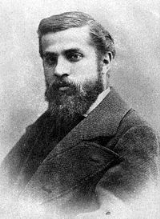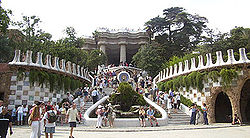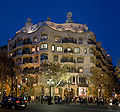
List of Gaudi Buildings
Encyclopedia
Antoni Gaudí
was an architect
from Catalonia
, Spain
, who belonged to the Modernisme
(Art Nouveau
) movement and was famous for his unique style and highly individualistic designs.
Gaudí, as an architecture student at the Escola Tècnica Superior d'Arquitectura in Barcelona
from 1873 to 1877, achieved only mediocre grades but did well in his "trial drawings and projects." After five years of work, he was awarded the title of architect in 1878. As he signed Gaudí's title, Elies Rogent declared, "Qui sap si hem donat el diploma a un boig o a un geni: el temps ens ho dirà" ("Who knows if we have given this diploma to a nut or to a genius. Time will tell.")
The newly named architect immediately began to plan and design and would remain affiliated with the school his entire life.
Antoni Gaudí
Antoni Gaudí i Cornet was a Spanish Catalan architect and figurehead of Catalan Modernism. Gaudí's works reflect his highly individual and distinctive style and are largely concentrated in the Catalan capital of Barcelona, notably his magnum opus, the Sagrada Família.Much of Gaudí's work was...
was an architect
Architecture
Architecture is both the process and product of planning, designing and construction. Architectural works, in the material form of buildings, are often perceived as cultural and political symbols and as works of art...
from Catalonia
Catalonia
Catalonia is an autonomous community in northeastern Spain, with the official status of a "nationality" of Spain. Catalonia comprises four provinces: Barcelona, Girona, Lleida, and Tarragona. Its capital and largest city is Barcelona. Catalonia covers an area of 32,114 km² and has an...
, Spain
Spain
Spain , officially the Kingdom of Spain languages]] under the European Charter for Regional or Minority Languages. In each of these, Spain's official name is as follows:;;;;;;), is a country and member state of the European Union located in southwestern Europe on the Iberian Peninsula...
, who belonged to the Modernisme
Modernisme
Modernisme was a cultural movement associated with the search for Catalan national identity. It is often understood as an equivalent to a number of fin-de-siècle art movements, such as Art Nouveau, Jugendstil, Secessionism, and Liberty style, and was active from roughly 1888 to 1911 Modernisme ...
(Art Nouveau
Art Nouveau
Art Nouveau is an international philosophy and style of art, architecture and applied art—especially the decorative arts—that were most popular during 1890–1910. The name "Art Nouveau" is French for "new art"...
) movement and was famous for his unique style and highly individualistic designs.
Gaudí, as an architecture student at the Escola Tècnica Superior d'Arquitectura in Barcelona
Barcelona
Barcelona is the second largest city in Spain after Madrid, and the capital of Catalonia, with a population of 1,621,537 within its administrative limits on a land area of...
from 1873 to 1877, achieved only mediocre grades but did well in his "trial drawings and projects." After five years of work, he was awarded the title of architect in 1878. As he signed Gaudí's title, Elies Rogent declared, "Qui sap si hem donat el diploma a un boig o a un geni: el temps ens ho dirà" ("Who knows if we have given this diploma to a nut or to a genius. Time will tell.")
The newly named architect immediately began to plan and design and would remain affiliated with the school his entire life.
Chronological listing
| Name | photo | World Heritage |
Location | Date Building | Coordinates |
|---|---|---|---|---|---|
| Cooperativa Obrera Mataronense | Mataró Mataró Mataró is the capital and largest city of the comarca of the Maresme, in the province of Barcelona, Catalonia Autonomous Community, Spain. It is located on the Costa del Maresme, to the south of Costa Brava, between Cabrera de Mar and Sant Andreu de Llavaneres, to the north-east of Barcelona. , it... |
1878–1882 | |||
| Sagrada Familia Sagrada Familia The ' , commonly known as the Sagrada Família, is a large Roman Catholic church in Barcelona, Catalonia, Spain, designed by Catalan architect Antoni Gaudí... |
yes | Barcelona Barcelona Barcelona is the second largest city in Spain after Madrid, and the capital of Catalonia, with a population of 1,621,537 within its administrative limits on a land area of... |
1882- | 41°24′13"N 2°10′28"E | |
| Casa Vicens Casa Vicens Casa Vicens is a family residence in Barcelona , designed by Antoni Gaudí and built for industrialist Manuel Vicens. It was Gaudí's first important work. It was added to the UNESCO World Heritage Site "Works of Antoni Gaudí" in 2005.... |
yes | Barcelona Barcelona Barcelona is the second largest city in Spain after Madrid, and the capital of Catalonia, with a population of 1,621,537 within its administrative limits on a land area of... |
1883–1888 | 41°24′13"N 2°09′04"E | |
| Park Güell Park Güell Park Güell is a garden complex with architectural elements situated on the hill of El Carmel in the Gràcia district of Barcelona, Catalonia, Spain. It was designed by the Catalan architect Antoni Gaudí and built in the years 1900 to 1914... |
 |
yes | Barcelona Barcelona Barcelona is the second largest city in Spain after Madrid, and the capital of Catalonia, with a population of 1,621,537 within its administrative limits on a land area of... |
1883–1888 | 41°24′49"N 2°09′10"E |
| Episcopal Palace of Astorga | Astorga (León León (province) León is a province of northwestern Spain, in the northwestern part of the autonomous community of Castile and León.About one quarter of its population of 500,200 lives in the capital, León. The weather is cold and dry during the winter.... ) |
1883–1913 | 42°27′28"N 6°03′21"W | ||
| El Capricho | Comillas Comillas Comillas is a small township and municipality in the northern reaches of Spain, in the autonomous community of Cantabria. The Marquisate of Comillas, a fiefdom of Spanish nobility, holds ceremonial office in the seat of power at a small castle which overlooks the town.-Marquis of Comillas:The first... (Cantabria Cantabria Cantabria is a Spanish historical region and autonomous community with Santander as its capital city. It is bordered on the east by the Basque Autonomous Community , on the south by Castile and León , on the west by the Principality of Asturias, and on the north by the Cantabrian Sea.Cantabria... ) |
1883-1985 | |||
| Güell Pavilions | Barcelona Barcelona Barcelona is the second largest city in Spain after Madrid, and the capital of Catalonia, with a population of 1,621,537 within its administrative limits on a land area of... |
1884–1887 | |||
| Palau Güell Palau Güell The Palau Güell is a mansion in Barcelona, Catalonia, Spain designed by the Catalan architect Antoni Gaudí for the Catalan industrial tycoon Eusebi Güell.It is part of the UNESCO World Heritage Site "Works of Antoni Gaudí".... |
 |
yes | Barcelona Barcelona Barcelona is the second largest city in Spain after Madrid, and the capital of Catalonia, with a population of 1,621,537 within its administrative limits on a land area of... |
1885–1890 | 41°22′44"N 2°10′27"E |
| Colegio de las Teresianas | Barcelona Barcelona Barcelona is the second largest city in Spain after Madrid, and the capital of Catalonia, with a population of 1,621,537 within its administrative limits on a land area of... |
1888–1889 | |||
| Casa Botines | León León, Spain León is the capital of the province of León in the autonomous community of Castile and León, situated in the northwest of Spain. Its city population of 136,985 makes it the largest municipality in the province, accounting for more than one quarter of the province's population... |
1891- | 42°35′54"N 5°34′14"W | ||
| Franciscan Missions in Tangier | Tangier Tangier Tangier, also Tangiers is a city in northern Morocco with a population of about 700,000 . It lies on the North African coast at the western entrance to the Strait of Gibraltar where the Mediterranean meets the Atlantic Ocean off Cape Spartel... |
1892 (unbuilt) | |||
| Bodegas Güell Bodegas Güell Bodegas Güell, in Catalan Celler Güell, is an architectural complex comprising a winery and associated buildings located in Garraf, in the municipality of Sitges , designed by the Catalonian architect Antoni Gaudí.-History and description:... |
Sitges Sitges *Church of Sant Bartolomeu i Santa Tecla . It houses two Gothic sepulchres , belonging to the an older church located on the same site... |
1895–1897 | |||
| Casa Calvet Casa Calvet Casa Calvet is a building, designed by Antoni Gaudí for a textile manufacturer which served as both a commercial property and a residence... |
Barcelona Barcelona Barcelona is the second largest city in Spain after Madrid, and the capital of Catalonia, with a population of 1,621,537 within its administrative limits on a land area of... |
1898–1900 | 41°23′27"N 2°10′23"E | ||
| Bellesguard Bellesguard Bellesguard , also known as Casa Figueres, is a modernist manor house designed by Catalan architect Antoni Gaudí, which was constructed between 1900 and 1909.It is located at the Sarrià-Sant Gervasi district of Barcelona... |
Barcelona Barcelona Barcelona is the second largest city in Spain after Madrid, and the capital of Catalonia, with a population of 1,621,537 within its administrative limits on a land area of... |
1900–1909 | 41°24′34"N 2°07′37"E | ||
| Casa Milà Casa Milà Casa Milà , better known as La Pedrera , is a building designed by the Catalan architect Antoni Gaudí and built during the years 1905–1910, being considered officially completed in 1912... |
 |
yes | Barcelona Barcelona Barcelona is the second largest city in Spain after Madrid, and the capital of Catalonia, with a population of 1,621,537 within its administrative limits on a land area of... |
1905–1907 | 41°23′43"N 2°09′42"E |
| Artigas Gardens Artigas Gardens The Artigas Gardens are a park in Lillet, province of Barcelona, Spain. Built between 1905 and 1906, and were designed by the modernist architect Antoni Gaudí.- History and description :... |
La Pobla de Lillet La Pobla de Lillet La Pobla de Lillet is a municipality in the comarca of the Berguedà inCatalonia. It is located in the upper valley of the Llobregat river and is linked to Guardiola de Berguedà by Road B-402.... |
1905–1906 | |||
| Casa Batlló Casa Batlló Casa Batlló is a building restored by Antoni Gaudí and Josep Maria Jujol, built in the year 1877 and remodelled in the years 1904–1906; located at 43, Passeig de Gràcia , part of the Illa de la Discòrdia in the Eixample district of Barcelona, Spain... |
yes | Barcelona Barcelona Barcelona is the second largest city in Spain after Madrid, and the capital of Catalonia, with a population of 1,621,537 within its administrative limits on a land area of... |
1905–1907 | 41°23′30"N 2°09′54"E | |
| Church of Colònia Güell Church of Colònia Güell The Church of Colònia Güell is an unfinished work by Antoni Gaudí. It was built as a place of worship for the people in a manufacturing suburb in Santa Coloma de Cervelló, near Barcelona . Colònia Güell was the brainchild of Count Eusebi de Güell... |
 |
yes | Santa Coloma de Cervelló Santa Coloma de Cervelló Santa Coloma de Cervelló is a municipality situated in the comarca of Baix Llobregat, at the province of Barcelona, Catalonia, Spain. The town has 7081 people.... (Barcelona Barcelona Barcelona is the second largest city in Spain after Madrid, and the capital of Catalonia, with a population of 1,621,537 within its administrative limits on a land area of... ) |
1908–1914 | 41°21′49"N 2°1′41"E |
| Hotel Attraction Hotel Attraction Hotel Attraction was a proposed project by architect Antoni Gaudí, for a skyscraper in New York City.The project was commissioned in May 1908. Planned at a total height of 360 metres, it was probably unrealistic for its time... |
New York New York New York is a state in the Northeastern region of the United States. It is the nation's third most populous state. New York is bordered by New Jersey and Pennsylvania to the south, and by Connecticut, Massachusetts and Vermont to the east... |
1908 (unbuilt) |

